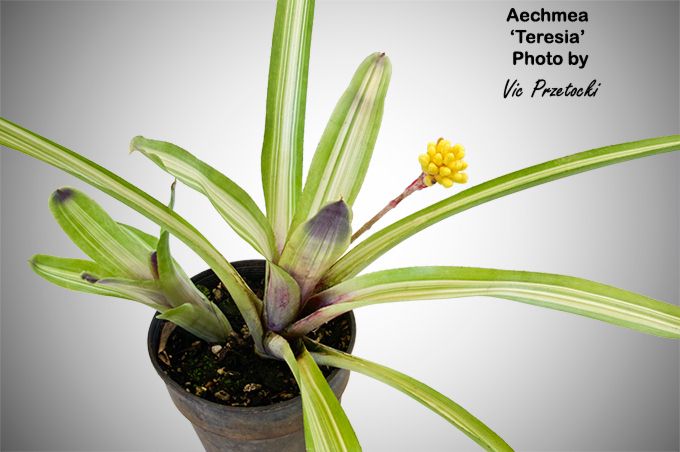

Aechmea ‘Teresia’ by Derek Butcher Nov 2016
In 2004 Teresia Stehl described the following taxon.
Aechmea calyculata (E. Morren) Baker, var. variegata, T. Strehl, Divul. Mus. Cienc. Tecnol. – UBEA/PUCRS, Porto Alegre. N. 9, p. 25-32, dec. 2004
Type: Brasil, Rio Grande do Sul, Machadinho, Mata de galeria, margens do rio Uruguai, 9 V 2000. T. Strehl, 1327 (Holotype. HAS 43043).
Paratype: Local coletor e data de origem nao citados, em cultivo na colecao do Jardim Botanico da FZB, floresceu em cultivo, 15.V.2000: (HAS 43044).
A Aechmea calyculata var. calyculata cui affinis est, set in lamina foliarum striata differt.
In recent years we have seen variegated plants going out of fashion by most botanists because they are a mutation and cannot be replicated by seed. So this particular variegated plant is treated as with the type in The World Check list of Selected plant families maintained by Kew Gardens and not being recorded in Reflora maintained by the Brazilians.
Regrettably there is inconsistency in interpretation of what should be infra-specific. For example in the latest Monograph entitled “Taxonomic revision of Bromeliaceae subfam. Tillandsioideae based on a multi-locus DNA sequence phylogeny and morphology” we see Lutheria splendens var striatifolia as an accepted variety but a var variegata reduced to a synonym under Pseudalcantarea macropetala. From the cultivar point of view it is interesting that the variegated form of Pseudalcantarea macropetala is registered as ‘Silver Candelabra’. On the other hand Lutheria splendens var striatifolia does not seem to be in cultivation. In fact of all the many cultivar forms of Lutheria splendens that have been registered none have been variegated. Therefore, Lutheria splendens var striatifolia could easily have disappeared into synonymy without a care by Bromeliad growers.
We know that this variegated Aechmea calyculata is being grown in Brazil, the USA, and Australia. So that it can be recorded in the Bromeliad Cultivar Register I am proposing to register it as Aechmea ‘Teresia’.